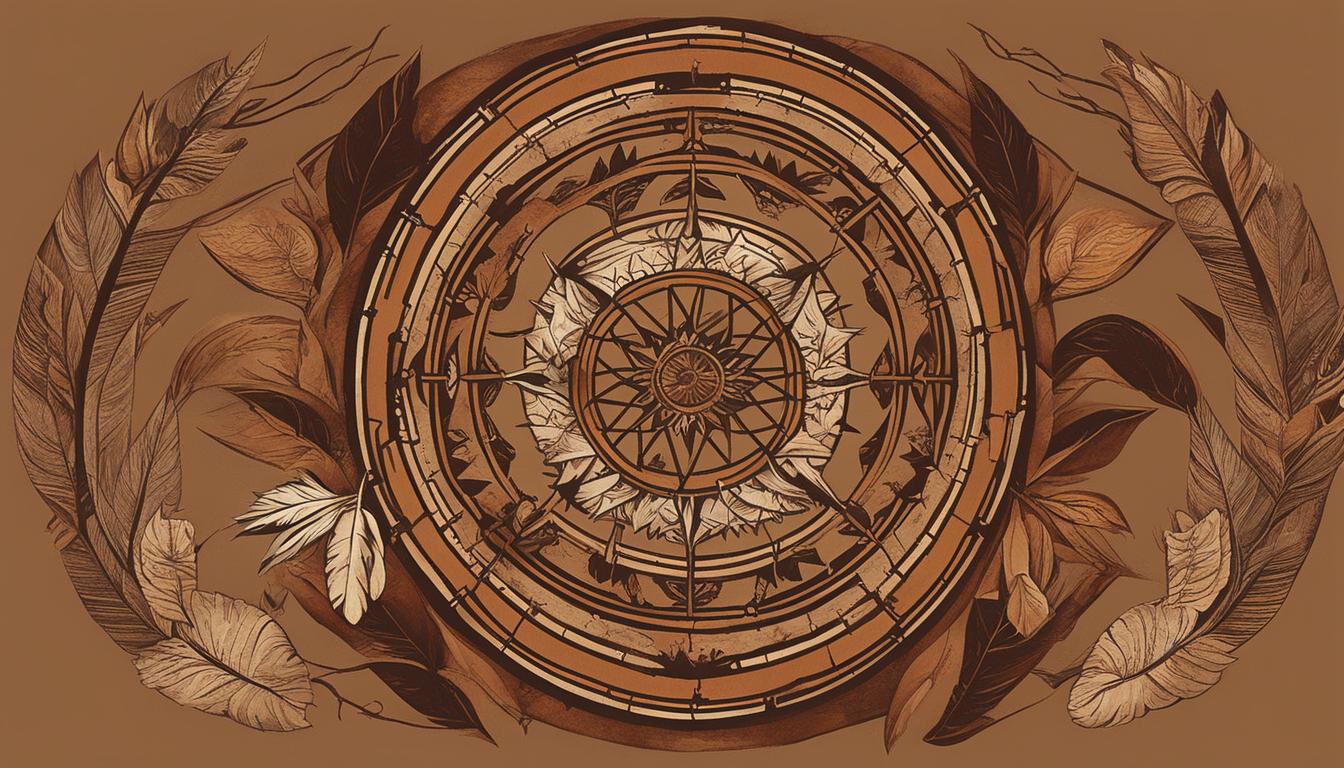Ever wondered about the meaning behind Native American symbols? They’re not just fancy designs but carry **deep cultural and spiritual significance**. **Passed down through generations**, these symbols are still super important in Native American culture today. Take the arrow, for instance. It stands for protection and defense. And the bear? It symbolizes spiritual power and courage. **Every symbol has a story** and a powerful meaning, waiting to be discovered.
Key Takeaways:
- Native American symbols carry deep cultural and spiritual significance.
- These symbols have been passed down through generations.
- Each symbol represents a unique story and holds profound meaning.
- Some common symbols include the arrow, bear, buffalo, butterfly, and eagle.
- These symbols bridge the gap between the visible and the spiritual world.
The Arrow and Arrowhead
The arrow is a symbol of protection and defense in Native American culture. It represents the literal bow and arrow used for hunting in tribes across the continent. This powerful symbol embodies the courage and skill required for survival in the natural world.
With its slender and pointed shape, the arrowhead carries its own significance. It not only serves as a physical tool for hunting and warfare, but also as a symbol of alertness and direction. The arrowhead reminds us to stay vigilant and focused in order to navigate life’s challenges.
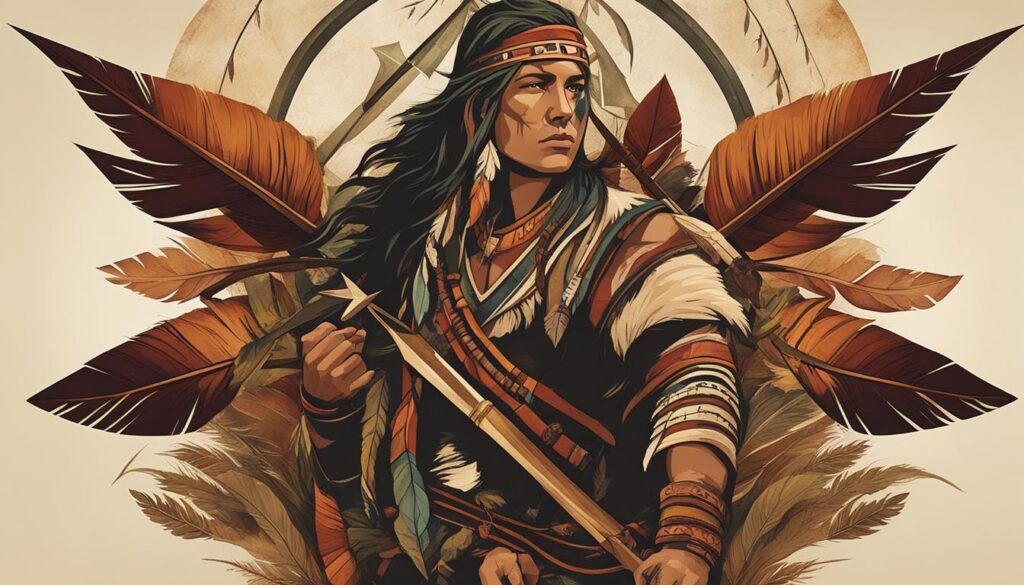
The Bear and Bear Claw
The bear is a sacred animal in Native American culture, symbolizing spiritual and physical power as well as courage. It is revered for its strength and resilience, embodying the qualities that Native Americans strive to possess.
The bear claw, on the other hand, holds deep symbolism and significance. It represents protection and is seen as a talisman of strength and bravery. Native Americans wear bear claws as a symbol of their connection to the bear spirit and their aspiration for leadership.
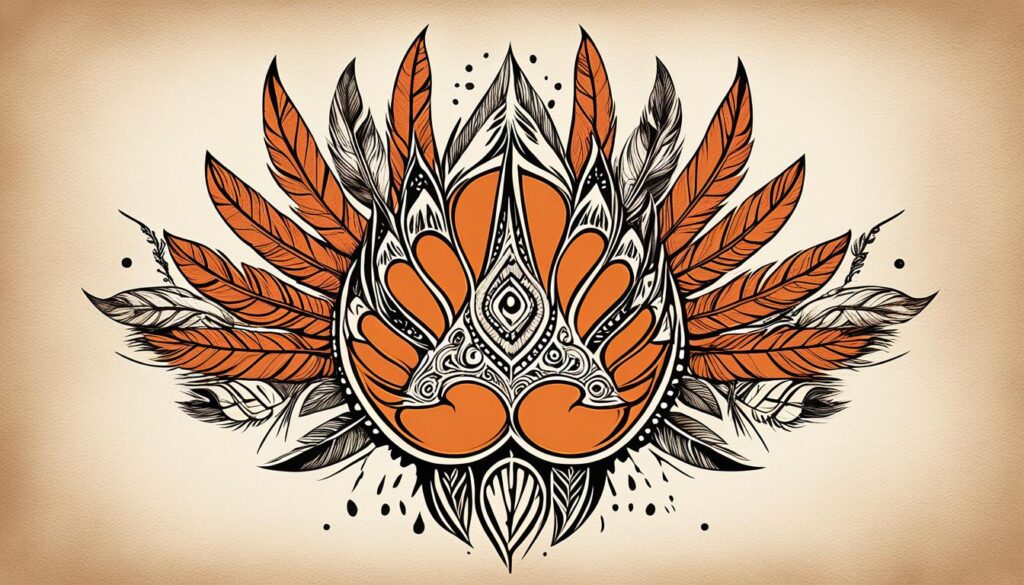
The Spiritual Power of the Bear
In Native American culture, the bear is associated with spiritual power. It is believed to possess a strong connection to the spiritual realm and is often seen as a guardian and guide. The bear’s immense strength and fearlessness serve as a reminder of the importance of courage and perseverance.
The bear is like a mighty force of nature, embodying both the physical and spiritual power that we seek. Its energy inspires us to tap into our own inner strength and face life’s challenges with courage and determination.
The Bear Claw as a Symbol
The bear claw is a symbol of protection and defense. It represents the ability to overcome obstacles and protect oneself and loved ones from harm. Native Americans believe that wearing a bear claw brings luck, strength, and courage.
Traditionally, the bear claw is worn as a pendant or incorporated into jewelry. It serves as a constant reminder to stay connected to one’s inner power and embrace the qualities of the bear.
Leadership and the Bear Claw
In Native American culture, wearing a bear claw is often associated with leadership. It is believed that those who possess the bear’s spirit and wear the claw have the qualities needed to guide and protect their community.
“The bear claw represents not only strength and protection but also the responsibility and courage that come with leadership. It is a symbol of the leader’s commitment to the well-being of their people and the ability to make wise decisions.”
The Importance of the Bear and Bear Claw
The bear and bear claw hold significant spiritual and cultural meaning in Native American traditions. They teach us the value of inner strength, courage, and the ability to protect oneself and others. These symbols remind us to tap into our own power and embrace the qualities of the bear as we navigate life’s challenges.
| Bear Symbolism | Bear Claw Symbolism |
|---|---|
| Spiritual and physical power | Protection and defense |
| Courage and resilience | Connection to the bear spirit |
| Guidance and strength | Leadership and responsibility |
Brotherhood and Loyalty
In Native American culture, the concept of brotherhood holds a deep significance. It represents the strong bond and loyalty between individuals or tribes, fostering unity and solidarity. Brotherhood goes beyond blood relations to encompass a sense of kinship and mutual support among members of a community.
This belief in brotherhood emphasizes the importance of standing together and supporting one another, especially in times of adversity and challenges. Native American tribes understand the power of collective strength and the benefits of cooperation and collaboration.
Brotherhood also symbolizes duality and balance in relationships. Just as brothers have a unique connection, Native American tribes seek to establish harmony and equilibrium within their communities. This balance promotes understanding, respect, and fairness among individuals, ensuring the smooth functioning of social structures.
Moreover, brotherhood extends beyond human relationships to include a deep sense of connection with nature and the spiritual world. Native American tribes recognize the interconnectedness of all living beings and their responsibility to maintain harmony with the natural world.
“In brotherhood, we find strength and balance. Together, we can overcome any challenge and achieve greatness.”
By honoring the bonds of brotherhood and embracing loyalty, Native American cultures emphasize the value of unity and shared goals. The sense of belonging and unity fostered by brotherhood creates a strong foundation for communities to thrive and prosper.
The Dual Nature of Brotherhood
Brotherhood carries a dual nature in Native American culture, representing both deep bonds within a tribe and the recognition of the duality of existence. This duality encompasses the concept of balance and the interconnectedness between opposing forces.
Native American tribes understand that life is a delicate balance between light and dark, joy and sorrow, creation and destruction. Brotherhood serves as a reminder to maintain equilibrium and embrace both sides of this duality.
Just as brothers support and uplift each other, Native American traditions emphasize the importance of finding balance within oneself and within relationships. This balance extends to the broader context of the natural world, where opposing forces coexist in a delicate dance of creation and renewal.
The Symbolism of Brotherhood
Brotherhood is often depicted in Native American art and symbolism through visual representations of siblings or intertwined figures. These images serve as a reminder of the interconnectedness of all beings and the importance of fostering strong relationships.
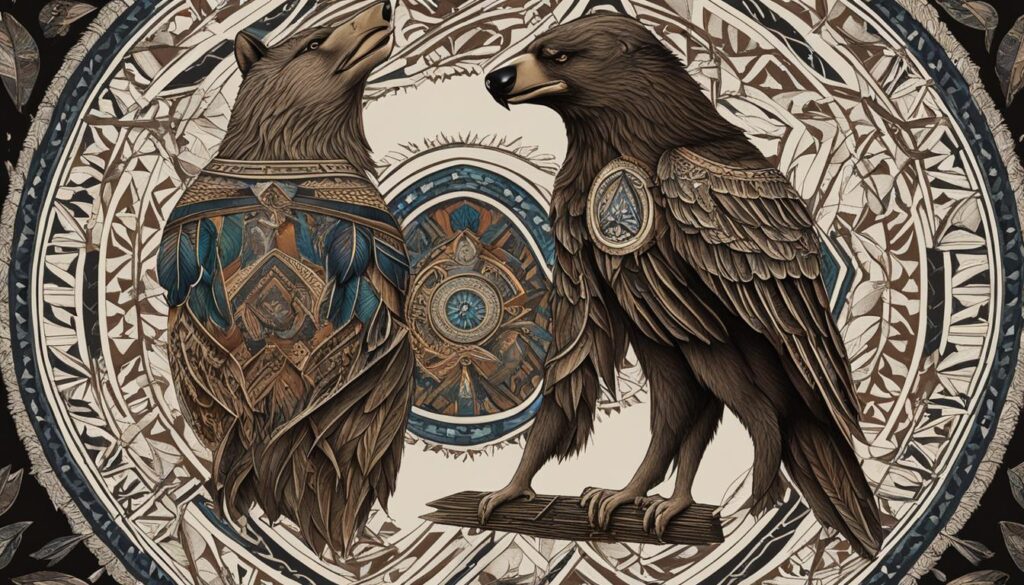
This image showcases two figures locked in an embrace, symbolizing the bond of brotherhood. The intertwined bodies represent unity, while the circle formed by their arms signifies the eternal nature of this connection.
Through the symbolism of brotherhood, Native American cultures impart the values of loyalty, unity, balance, and interconnectedness. By embracing brotherhood, individuals and tribes can cultivate a sense of community and foster harmonious relationships, ultimately contributing to a more balanced and interconnected world.
The Buffalo and Humbleness
The buffalo, also known as the American Bison, holds great cultural significance in Native American culture. It serves as a symbol of sustenance, providing both food and materials for various aspects of everyday life. The buffalo embodies the idea of sustaining life and the importance of taking only what one needs.
The Native American tribes relied heavily on the buffalo for survival, utilizing every part of the animal to honor its sacrifice. The meat provided nourishment, the hide was used for clothing and shelter, and the bones and horns were transformed into tools and instruments. This sustainable approach to utilizing the buffalo’s resources exemplifies the value of humbleness and gratitude towards nature.
“The buffalo is a majestic creature that teaches us to live in harmony with the land and appreciate the interconnectedness of all living beings. Its humbling presence reminds us of the delicate balance required to sustain life.” – Chief Running Water
The buffalo is not only a physical presence in Native American culture but also holds a spiritual significance. It symbolizes strength, abundance, and resilience. Native American tribes believe that the buffalo possesses sacred wisdom and that its spirit can guide humans in navigating the challenges of life.
By embodying the spirit of the buffalo, individuals are encouraged to embrace humbleness, recognizing their place within the greater ecosystem. They learn to respect and honor the resources provided by the earth, understanding that taking more than necessary disrupts the delicate equilibrium of nature.
Buffalo Population in North America
Over the centuries, the buffalo population in North America has faced significant challenges due to human activities and environmental changes. In the 19th century, mass hunting and habitat destruction led to a drastic decline in the buffalo population, bringing it dangerously close to extinction.
However, conservation efforts and a growing awareness of the importance of preserving this iconic species have helped revive the buffalo population. Today, the American Bison is considered a conservation success story, with efforts to protect and restore their habitats proving fruitful.
Here is a table showing the estimated population of American Bison in North America:
| Year | Estimated Population |
|---|---|
| 1800 | 30-60 million |
| 1890 | 700 |
| 2021 | approximately 500,000 |
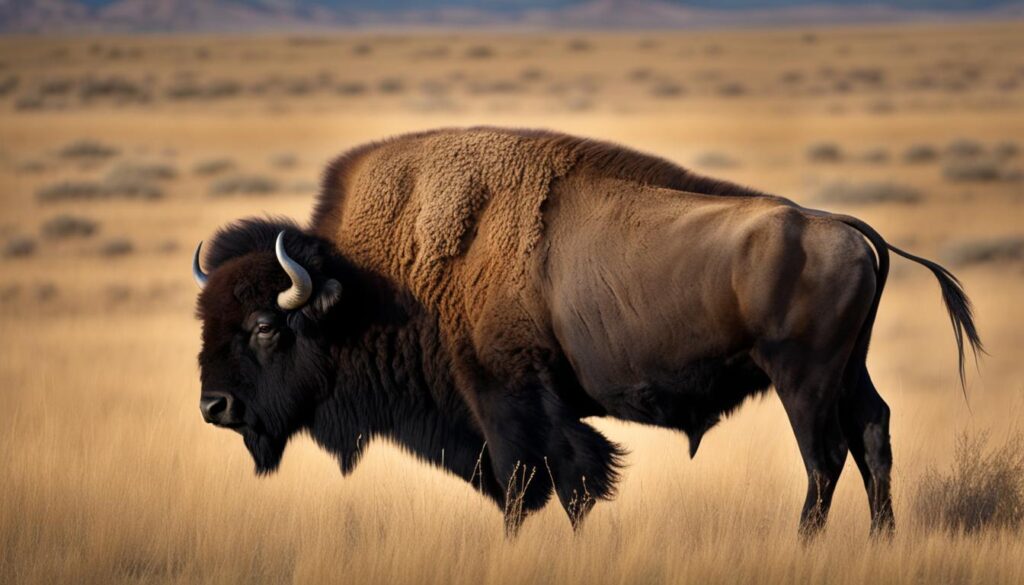
The Butterfly and Transformation
The butterfly is a common symbol in Native American jewelry, representing transformation and rebirth. It is believed to carry powerful spiritual messages and is seen as a messenger from the spirit world. This beautiful creature undergoes a remarkable metamorphosis, transitioning from a humble caterpillar to a magnificent butterfly, symbolizing the potential for personal growth and change.

The butterfly’s journey from a crawling insect to a vibrant flyer is a symbol of transformation. Its transformative process inspires Native Americans to embrace positive change, leaving behind old patterns and embracing new beginnings. Just like the butterfly emerges from its cocoon, individuals can also shed their limitations and embrace their true potential.
Furthermore, the butterfly is considered a messenger from the spirit world. Native American tribes believe that these delicate creatures bring messages of peace, harmony, and spiritual growth. As a messenger, the butterfly acts as a bridge between the physical and spiritual realms, reminding us of the interconnectedness of all living beings.
| Symbol | Representation |
|---|---|
| Transformation | The metamorphosis from caterpillar to butterfly signifies personal growth and change. |
| Rebirth | The butterfly’s emergence from the chrysalis represents new beginnings and fresh start. |
| Messenger from the spirit world | The butterfly carries messages of peace, communication, and spiritual growth. |
“Like a butterfly, we too can transform and leave behind the burdens of the past, embracing a beautiful journey of self-discovery and growth.” – Native American Proverb
Appreciation for the butterfly’s transformative journey extends beyond symbolism. Native American artisans depict butterflies in their art and jewelry, honoring the beauty and significance of this enchanting creature. The butterfly’s delicate wings and vibrant colors serve as a reminder to embrace change and find beauty in every stage of life.
The Cactus and Endurance
In Native American culture, the cactus is recognized as a powerful symbol of protection and endurance. Just like the cactus thrives in the tough desert conditions, it serves as a reminder to withstand difficult situations and persevere through challenging times.
The cactus’s ability to survive and flourish in arid environments speaks to its remarkable endurance. Despite the harsh conditions it faces, the cactus stands tall and continues to grow, representing the resilience and strength that individuals can possess.
Similar to how the cactus’s spines provide physical protection, this symbol also represents the need for emotional and spiritual protection. It encourages individuals to guard themselves against negativity, harmful influences, and challenging circumstances.
Moreover, the cactus teaches the importance of adaptation and the ability to thrive in unfavorable conditions. It exemplifies the capacity to make the best of any situation and find opportunities for growth and flourishing, even in the face of adversity.
Embracing the qualities of the cactus can bring about a sense of inner strength and the determination to overcome obstacles. It encourages individuals to stay true to their values and beliefs, unwavering in the face of challenges, and steadfast in their pursuit of goals.
Endurance and Protection in Native American Culture
The Native American people have long recognized the cactus as a powerful symbol of endurance and protection. It is often incorporated into traditional tribal ceremonies, artwork, and jewelry, signifying its cultural significance.
“The cactus teaches us to withstand the hardships of life and reminds us that protection is not just physical, but also encompasses emotional and spiritual well-being.” – Chief Standing Bear
Native American tribes infuse these symbols into their daily lives to draw strength and guidance from the natural world around them. Through the enduring presence of the cactus, they find solace in their ability to withstand life’s challenges and protect what is most important to them.
As with all symbols, the interpretation of the cactus may vary among different Native American tribes and individuals. However, its essence of endurance and protection remains a central theme across Native American cultures.
Image of a Cactus
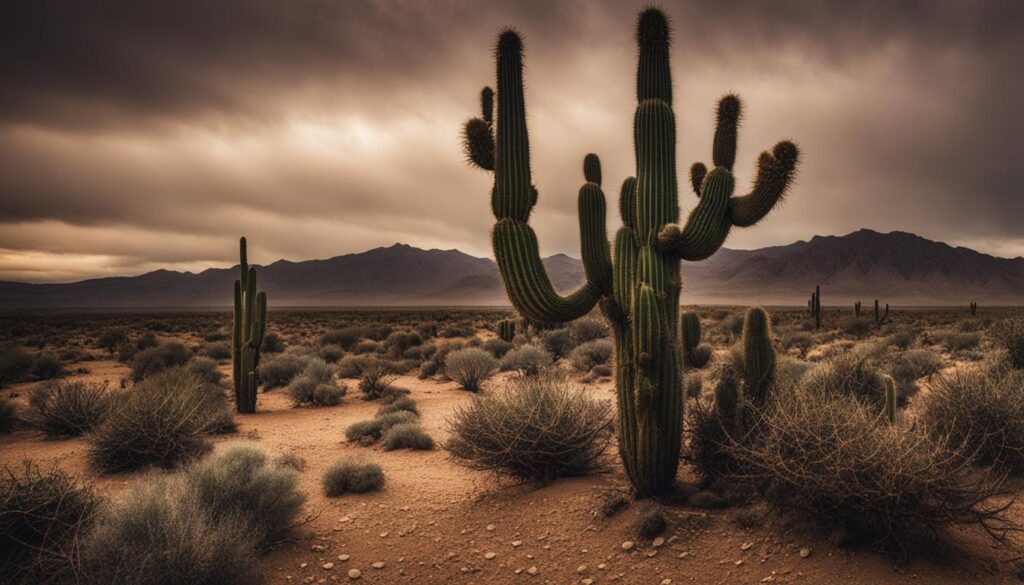
| Symbol | Meaning |
|---|---|
| Cactus | Protection and endurance |
| Arrow | Direction and defense |
| Bear | Spiritual power and courage |
The Circle and Its Variations
In Native American culture, the circle symbolizes a multitude of meanings and holds significant importance. It is a powerful representation of unity, interconnectedness, and the cyclical nature of life. The circle can be found in various forms throughout Native American art and symbolism, embodying profound concepts such as the four elements, changing seasons, and the cycle of death and rebirth.
The circle’s association with the four elements is a testament to the deep connection Native Americans have with nature. Earth, air, fire, and water are believed to be the foundational elements of life, and the circle serves as a visual representation of their harmonious existence.
Furthermore, the changing seasons are beautifully depicted through the circle symbol. Native American cultures revere the natural cycle of growth, decay, and renewal, as it mirrors the cycle of life itself. The circle reminds us of the ever-changing cycles of the natural world and our own existence within it.
Death and rebirth are fundamental themes represented by the circle symbol. Native Americans view death not as an end, but as a transition to the spirit world and a new beginning. The circle embodies the continuous cycle of life, where death is seen as a necessary part of the eternal circle of existence.

Additionally, the circle signifies the first four tribes of mankind, each symbolizing a particular aspect of human nature. These tribes, often portrayed as four points on a circle, represent the diverse qualities and characteristics that make up the human race.
The circle’s symbolism in Native American culture is a compelling reminder of the interconnectedness of all things and the profound wisdom passed down through generations. It invites us to reflect on our place in the natural world, the cycles of life, and the enduring significance of Native American traditions.
Corn and Corn Maze/Maize
Corn holds a significant place in Native American culture and symbolism. It represents not only a widely harvested crop but also embodies the resilience and abundance of life. The Native American tribes cultivated corn as a staple crop, relying on its sustenance for survival and nourishment.
The corn maze, on the other hand, is a creative representation of the twists and turns of life. Just as navigating a maze requires patience, determination, and adaptability, life itself is filled with unexpected challenges and opportunities. The corn maze serves as a metaphor for the journey we all embark on, full of unexpected twists and turns.

Walking through a corn maze can evoke a sense of adventure and excitement. As you wind your way through the towering stalks, each corner turned brings a new discovery, a hidden path, or an unexpected dead-end. It mirrors the complexity of life, urging us to navigate uncertainty with open minds and a willingness to explore new possibilities.
“Life is like a corn maze. Every turn and decision may bring surprises and challenges, but it’s up to us to find our way through.”
The corn maze symbolizes the journey of self-discovery, offering a chance to reflect on one’s own path in life. It encourages us to embrace change, make decisions, and ultimately find our way back to our true selves. Just as a corn maze can be both challenging and rewarding, the twists and turns of life shape us into who we are and lead us to new beginnings.
The Coyote and Intelligence
The coyote holds great significance in Native American culture, representing more than just a wild animal found in North America. It is believed to embody the traits of a creator god, a wise spirit, and an ancestor. The coyote’s intelligence and craftiness are highly regarded, making it a symbol associated with cleverness and wit.
Native American tribes often tell stories and myths featuring the cunning coyote as a central character. These tales serve as cautionary tales or moral lessons, showcasing the coyote’s ability to outsmart others or navigate tricky situations. The coyote’s intelligence is not only seen as a survival skill but also as a source of inspiration for problem-solving and adaptability.
One popular Native American tale highlights the coyote’s intelligence in securing food for his tribe during times of scarcity. In this story, the coyote successfully devises clever strategies to outwit larger and stronger animals, showcasing his resourcefulness and quick thinking.
“The coyote, with its swift reflexes and sharp mind, symbolizes the intelligence and wisdom that can guide us through life’s challenges. It reminds us to approach problems creatively, using our intelligence to find solutions.”
In Native American art and jewelry, the coyote is often represented with symbols that further emphasize its intelligence and spiritual significance. These symbols may include intricate patterns, depictions of the natural world, or elements associated with creation.
To truly appreciate the depth of the coyote’s symbolism in Native American culture, it’s essential to understand its connection to the creator god and its role as a wise and crafty spirit. The coyote’s intelligence serves as a reminder to embrace our own mental abilities and learn from the wisdom of the natural world.
| Coyote Symbolism | Explanation |
|---|---|
| Creator God | The coyote represents a creator god in Native American mythology who played a role in shaping the world. |
| Spirit and Ancestor | The coyote is seen as a spiritual presence, guiding individuals with its intelligence and offering protection. |
| Intelligence and Craftiness | The coyote’s ability to outsmart others in stories and myths highlights its intelligent and clever nature. |

The coyote’s symbolism remains deeply rooted in Native American culture, reminding us of the importance of intelligence, wit, and adaptability in navigating the complexities of life.
The Dragonfly and Freedom
The dragonfly, a symbol of freedom and swift movement, holds great significance in Native American cultures. This graceful insect represents the ability to navigate life’s challenges with agility and adaptability. Just as the dragonfly effortlessly glides through the air, it reminds us to embrace change and embrace the opportunities that arise from it.
The dragonfly’s association with resurrection adds another layer of symbolism. Much like the dragonfly emerging from its nymph stage to take flight, it symbolizes the ability to overcome adversity and find new beginnings. In Native American traditions, the dragonfly is seen as a powerful spirit guide that assists individuals in rising above hardship and rebuilding their lives.
There are several Native American tribes that believe the dragonfly is a messenger of transformation and renewal. Its delicate wings and vibrant colors symbolize the beauty that can emerge from even the most challenging circumstances. Additionally, the dragonfly’s swift movement through the air signifies the freedom to transcend limitations and soar towards infinite possibilities.
“The dragonfly is a symbol of freedom and hope. Its swift movement and ability to adapt remind us of the strength we possess to overcome any obstacles in our lives.” – Native American proverb
Dragonfly Symbolism in Native American Tribes
Native American tribes have different interpretations of the dragonfly’s symbolism, but the theme of freedom and resurrection remains consistent. For example, in the Hopi tribe, the dragonfly is associated with water and represents purity, grace, and the ability to navigate emotions with ease. In other tribes, the dragonfly is seen as a symbol of transformation and change, inspiring individuals to embrace personal growth and explore new horizons.
No matter the specific interpretation, the dragonfly’s symbolism resonates deeply within Native American cultures and serves as a reminder of the resilience and strength of the human spirit. It encourages individuals to embrace their own inner power and strive for personal liberation.

Dragonfly in Art and Jewelry
The dragonfly’s beauty and symbolism have inspired many Native American artists and craftsmen. Its graceful form is often incorporated into intricate designs in pottery, textiles, and jewelry. Dragonfly motifs are commonly found in necklaces, earrings, and rings, serving as reminders of the values associated with this fascinating creature.
Native American jewelry featuring dragonfly designs often conveys a sense of freedom, agility, and strength. These pieces not only showcase the artistry and craftsmanship of the Native American culture but also allow individuals to carry the powerful symbolism of the dragonfly with them.
Dragonfly: A Guide to Freedom and Resurrection
The dragonfly’s symbolism of freedom and resurrection offers valuable insights and teachings that can be applied to our own lives. It reminds us to embrace change, adapt to new situations, and find the inner strength to overcome challenges. The dragonfly encourages us to rise above adversity and rebuild our lives in a way that aligns with our truest selves.
Next time you spot a dragonfly gracefully flitting through the air, take a moment to appreciate its symbol of freedom and resurrection. Let it serve as a reminder of your own inner power and the infinite possibilities that await you.
The Eagle and Personal Power
The eagle holds a significant place in Native American culture, symbolizing victory, conquest, and personal power. Revered for its majestic presence and powerful flight, the eagle represents strength and courage. It is believed to possess an innate ability to soar above challenges and obstacles, inspiring individuals to tap into their own personal power.
In Native American traditions, the eagle is often associated with the pursuit of success and achieving one’s goals. Its sharp, focused gaze exemplifies unwavering determination and a relentless drive for victory. As such, the eagle serves as a powerful symbol for those seeking to overcome adversity and triumph in their endeavors.
Just as the eagle possesses the ability to fly to great heights, it encourages individuals to elevate themselves and strive for greatness. With its keen eyesight, the eagle serves as a guide, helping individuals navigate through life’s challenges and find their true path to success.
The Eagle’s Symbolism
The eagle’s symbolism extends beyond personal power and victory. It is also associated with spiritual growth and enlightenment. In Native American culture, the eagle is believed to have a close connection with the divine, serving as a bridge between the earthly and spiritual realms.
Furthermore, the eagle’s wingspan represents freedom and liberation. It reminds individuals to spread their wings, break free from limitations, and embrace their full potential. Just as the eagle soars effortlessly through the sky, it calls upon individuals to rise above mediocrity and embrace their inner strength.
“The eagle has landed.”
Derived from the Latin word “aquila,” meaning eagle, the phrase “The eagle has landed” signifies a successful achievement or accomplishment. It echoes the eagle’s triumphant nature and embodies the essence of personal power and victory.

Summoning the Power of the Eagle
To harness the power of the eagle and tap into personal power, individuals can incorporate eagle imagery into their lives. This can be done through wearing jewelry or clothing adorned with eagle motifs, displaying eagle feathers, or simply visualizing the eagle’s strength and resilience in moments of challenge.
By connecting with the eagle’s energy and symbolism, individuals can draw upon its inherent power to overcome obstacles, achieve victory, and unleash their full potential. The eagle serves as a reminder that personal power is within reach, waiting to be embraced and utilized on the journey to success.
The Turtle and Long Life
In Native American symbolism, the turtle holds a special place as a representation of the earth itself. It is seen as a living embodiment of the earth’s longevity and stability, symbolizing a long and healthy life. The turtle’s slow and steady movements exemplify the importance of patience and perseverance in achieving longevity and success.
The turtle is highly respected among various Native American tribes for its ability to navigate both land and water, showcasing its adaptability and resilience. It serves as a reminder of the importance of harmonizing with our surroundings and embracing the cycles of life.

Symbolism of the Turtle:
“The turtle is a symbol of wisdom, protection, and stability. Its connection to the earth emphasizes the grounding and nurturing qualities associated with a long and fulfilling life.”
Furthermore, the turtle is often associated with good health. Its protective shell represents a shield against negative energies and outside influences, granting individuals the resilience to overcome life’s challenges.
Just as the turtle carries its home wherever it goes, Native American culture teaches the importance of being rooted in one’s heritage and staying connected to one’s values. This connection to the earth and one’s identity contributes to a sense of belonging and inner peace.
The Turtle and Native American Traditions:
Throughout Native American history, the turtle has played a significant role in various tribal rituals and practices. It is often depicted in rock art, pottery, and jewelry, reinforcing its symbolism and representing the interconnectedness of all living beings.
The turtle’s association with long life encourages individuals to live in harmony with nature and respect the natural world. This reverence for the earth and its creatures fosters a sense of responsibility towards future generations and the preservation of cultural traditions.
Celebrating Long Life:
Native American communities hold ceremonies and events to honor the turtle’s symbolism of long life. These gatherings often involve storytelling, dances, and rituals that emphasize the importance of wisdom, patience, and respect for all living things.
By embracing the teachings of the turtle, individuals can cultivate a greater appreciation for the earth’s gifts and strive for a balanced and fulfilling existence.
| Turtle Symbolism | Meaning |
|---|---|
| Longevity | The turtle represents a long and healthy life. |
| Protection | The turtle’s shell symbolizes protection against negative influences. |
| Stability | The turtle embodies the stability and grounding of the earth. |
| Wisdom | The turtle is associated with wisdom and patience. |
Water Wave Pattern and Renewal
The water wave pattern is a captivating design that holds deep significance in Native American art. It beautifully symbolizes renewal, life, and the cyclical nature of existence. Water, as an essential element, represents the source of life and the profound connection between all living beings.
In Native American culture, water is revered as a life-giving force that sustains and nurtures. The water wave pattern serves as a visual representation of the vitality and constant renewal found in the natural world. Just as water flows endlessly, life too undergoes constant change and transformation.
Through the intricate interplay of curves and lines, the water wave pattern captures the fluidity and energy of water. It is a reminder of the eternal cycle of birth, growth, death, and rebirth. This concept aligns with the belief in the interconnectedness of all things – that every ending is followed by a new beginning.

The water wave pattern is frequently incorporated into various forms of Native American art, including pottery, jewelry, and textiles. It serves as a powerful symbol that honors the life-sustaining qualities of water and the innate resilience of humanity.
“The water wave pattern mirrors the ebb and flow of life, reminding us to embrace change and find renewal amidst the challenges we face.”
Whether used as a decorative motif or a profound artistic statement, the water wave pattern invites us to reflect on the preciousness of life and the importance of adapting to the ever-changing tides. It encapsulates the Native American perspective on the inherent rhythm and harmony of existence.
Symbolizing Life’s Renewal
The water wave pattern evokes a sense of awe and wonder, reminding us of the perpetual cycle of renewal in nature. It encourages us to embrace change and embrace the opportunity for growth and transformation. By embracing the fluidity of life, we can discover new possibilities and nurture our own personal renewal.
Embracing the Flow of Life
The water wave pattern serves as a gentle reminder to let go of resistance and flow with the currents of life. It prompts us to release the need for control and instead trust in the natural rhythm of existence. By aligning ourselves with the flow of life, we can navigate challenges with grace and resilience.
Appreciating the Importance of Water
The water wave pattern also underscores the vital role of water in sustaining life. It encourages us to appreciate and protect this precious resource, recognizing its significance not only as a physical necessity but also as a symbol of renewal and rebirth.
Table
| Symbol | Meaning |
|---|---|
| Water Wave Pattern | Renewal, life, cyclical nature of existence |
| Water | Life-giving force, interconnectedness |
| Change | Adaptation, growth, transformation |
| Fluidity | Resilience, rhythm of existence |
| Renewal | Perpetual cycle, opportunity for growth |
| Flow | Embracing change, trust in natural rhythm |
| Water’s Importance | Physical necessity, symbol of renewal |
Conclusion
Native American symbols hold immense cultural significance and deep spiritual meanings. They represent the rich tapestry of Native American culture, offering a glimpse into their traditions and beliefs. These symbols serve as a bridge between the visible and the spiritual world, imparting wisdom and guidance to those who seek them.
Through their intricate designs and powerful symbolism, native American symbols continue to inspire and educate people around the world. They reflect the interconnectedness of nature, spirituality, and human existence. Each symbol carries its own unique message, conveying the values and experiences of Native American tribes throughout history.
By understanding the cultural significance and spiritual meanings of these symbols, we gain a greater appreciation for the traditions and heritage of Native American peoples. They remind us of the importance of preserving and respecting different cultures, creating a more inclusive and harmonious society. Native American symbols are more than just artistic expressions—they are windows into a profound and ancient wisdom that has the power to enrich our lives.
FAQ
What are Native American symbols?
What does the arrow symbolize in Native American culture?
What does the bear symbolize in Native American culture?
What does the concept of brotherhood represent in Native American culture?
What does the buffalo symbolize in Native American culture?
What does the butterfly symbolize in Native American culture?
What does the cactus symbolize in Native American culture?
What does the circle symbolize in Native American culture?
What does corn symbolize in Native American culture?
What does the coyote symbolize in Native American culture?
What does the dragonfly symbolize in Native American culture?
What does the eagle symbolize in Native American culture?
What does the turtle symbolize in Native American culture?
What does the water wave pattern symbolize in Native American culture?
Why are Native American symbols culturally significant?
What is the significance of Native American symbols compared to the meanings of the 12 Tribes of Israel names?
Native American symbols hold deep cultural and spiritual significance, representing traditions, stories, and connections to the natural world. Similarly, the meanings of Israeli tribes names are rooted in historical and religious significance, symbolizing heritage and identity for the Jewish people. Both serve as powerful symbols of a community’s beliefs and values.

